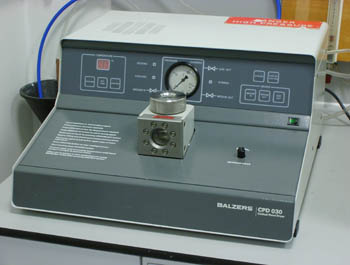Preparation Laboratories
The Laboratory provides a variety of sample preparation facilities.
Coaters
Non-conducting samples to be examined  need to be coated with a thin layer of metal prior to examination. The Electron Microscopy Laboratory has two sputter coaters for this purpose.
need to be coated with a thin layer of metal prior to examination. The Electron Microscopy Laboratory has two sputter coaters for this purpose.
The gold sputter coater is used for routine coating of High Vacuum SEM samples. This is suitable for samples that are to be viewed at low to medium magnifications.
The Laboratory's high resolution coater has two distinct functions; it can be used to deposit either a thin layer of chromium or a layer of carbon onto a surface. Either of these coatings will prevent electrical charging, which spoils the image.
The finely grained structure of chromium makes it particular useful for samples that are to be viewed with the microscopes high magnification ranges. Carbon, as a relatively light element, is a good coating for samples on which xray analysis will be performed.
Critical Point Drying
Critical Point Drying is a technique used to prepare naturally hydrated specimens for examination under high vacuum conditions in a scanning electron microscope. Air drying such specimens can result in damage, due to the surface tension of the evaporating water. Critical point drying avoids this problem by placing the specimen in an environment where the fluid within the specimen can pass from the liquid to gas phase with zero surface tension.
In practise it is necessary to fix the specimen and then transfer it into an 'intermediate fluid' (typically acetone or ethanol, as water is not miscible with carbon dioxide ). Within the instrument the intermediate fluid is exchanged for the 'transition fluid' (usually CO2).
Temperature and pressure are then controlled within the instrument to achieve the 'critical point' at which the density of the liquid and gas are the same. CO2 is the preferred transition fluid as its critical point is reached at 31ºC and 528 PSI (approx 73.8 bar), conditions which will leave biological samples undamaged. Once the carbon dioxide is fully converted to gas the specimen is dry.
Newly dried specimens are highly hygroscopic and must be coated with a thin layer of metal or carbon as soon as possible.
The Electron Microscopy Laboratory has two Critical Point Drying Systems. One is routinely available.